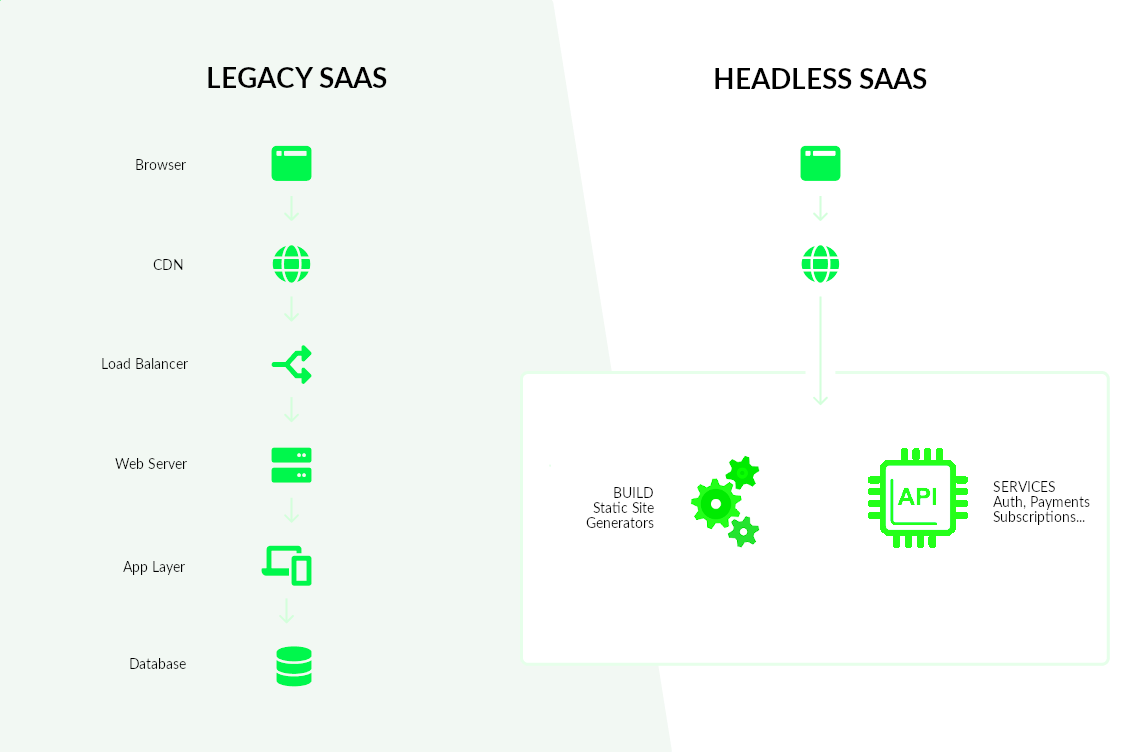Headless SaaS
Business Ready Open Source SaaS micro-services back-end solution stack to power web application delivery through edge networks for blazing speed while dramatically reducing cost, time, and effort in developing and deploying applications. Stack packs typical SaaS website modules such as user management, content, subscription, support, etc.
Overview
Headless software architecture pattern is about decoupling the front-end presentation layer of a website or web application from the back-end business functionality & data store. This clear separation enables a scalable way to serve front-end web pages. You get pages that aren’t “attached” to a single web server but are served from CDN. All the cache is saved on the client-side too, which boosts page loading speed dramatically - a strong parallel to how mobile applications function. Popularly known as the Jamstack, this new way of application delivery has already changed the way CMS applications work with a range of Headless CMS solutions. A similar change is now shaping eCommerce where the end-user-facing pages are statically generated and served through edge servers while the business logic is powered by an API first server - Headless eCommerce. The benefits to eCommerce are significant because many of them are used to power mobile applications too.
If you are new to JAM Stack, read about "The modern way to build Websites and Apps that delivers better performance"
The decoupled way of application delivery not only boots page speed which immediately improves user experience and SEO rankings, but helps organize developer effort too with structured reuse of features and a grossly simplified deployment workflow.

Headless SaaS Stack is an opinionated ground-up design with the following goals
-
Business Ready back-end microservices stack that covers a range of features that are common across typical SaaS applications such as user signup, subscriptions, payments, content pages such as blogs, resources, documentation, support & ticketing system, lead tracking, etc. Even if you are at the MVP stage, users have come to expect all of these to build confidence. Users expect a full-stack experience today and it is not inexpensive to meet that in the early stages of SaaS.
-
Reference Front-end implementation on popular frameworks like React, Angular & Vue or higher-order ones such as Next, Nuxt, Gatsby, Gridsome, etc. Developers can utilize their front-end technology of choice to deliver high-quality web experiences, and plug into the headless saas back-end that manages all business functionality.
Who should use this stack?
-
New SaaS solutions of course. Can help you cut down on initial development by months. Headless SaaS Stack can be an excellent starting point for core application functions and features too.
-
Existing SaaS solutions upgrading web infrastructure can leverage robust well-designed services to
- Cut down on cost and time to deliver applications.
- Simplify DevOps and deployment workflows.
- Harvest best practices when it comes to speed, security, compliance, and administration.
Specifications
This is a highly opinioned stack to cover starting from zero to well over 100s of 1000s users. Once you go past million users the scale and complexity change. However, this stack should still provide a good building block for the next million and more.
Architecture & Design
Based on micro-services architecture here are the key goals.
- Minimum components - reduce future maintenance costs and risks.
- Clear License - MIT, Apache or compatible license only.
- Any cloud - AWS, Azure, GCP, Digital Ocean, etc or even own data center.
- Clear Documentation - The stack is by design extensible. Comes with clear documentation.
- Reference front-end design for React, Vue & Angular
- Development best practices such as IDE, debugging, testing, deployment, monitoring, etc.
Technology stack
- Node.js with support for both common javascript and typescript. The selection is based on the speed of development, deployment, and execution, a large ecosystem of modules and libraries, and an available talent pool.
- Mongo DB, the popular document database.
Application Modules
User Management
Registration, social signup, authentication, rights & access management of members, onboarding, and audit.
Secruity
- Strong password
- Multi-factor support (optional)
- Fraud detection
Subscription & Billing
- Product Catalog, Prices, Discounts, Promotions / Coupons model
- Integration with payment systems such as Stripe
- Subscription Reports, Audit Trail
Business & Marketing Tools
Covered through integrated 3rd party systems
- CRM integrations with popular systems such as HubSpot
- Newsletters
- Site, visitor metrics, and engagement
- Promotions & Campaigns
Referrals && Partnership Management
The growth of SaaS depends a lot on service partners and referrals. Integrated setup for existing users to refer and distribute.
Contact Management & Support
- Integrated with systems popular with SaaS companies.
- Live chat integrations. This is mostly font-end but user identification to trigger application delivery changes for better conversion.